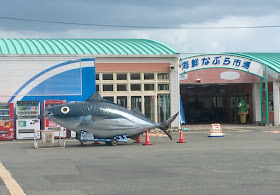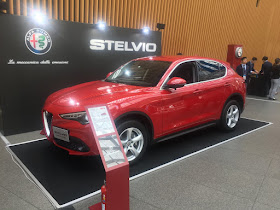 |
| The big fish at Omaezaki Port |
This time, the main goal was that Jerome qualify for PBP. (I already did so with my Tasmania series, so was just "along for the ride" and the training.) He had chosen really, really tough 300km and 400km events, and so it was with some relief that I joined him for this 600km brevet.
ONLY ~6000 meters or so of elevation gain (ridewithgps says 6800m, route labo says 5605m, my GPS unit recorded 5900+), on a course that was familiar and offered many rewards. The weather forecast looked good -- dry and not too hot nor too cold, tailwinds along the coast near the start!
But it was not easy. 600km never is. The main surprise was a very stiff headwind on the return leg, that slowed us (and others) to a crawl and forced us to manage our time carefully on what otherwise should have been a fast return course.
As we neared Okitsu on Friday night, Jerome mentioned that he did not bring a reflective vest. He planned to get by with only a reflective "slow moving vehicle" triangle. I groaned -- what if the Audax staff did not let him start? Or someone complained during the ride? It depends on the group, but many local groups in Japan would not accept just a rear triangle. I gave him my extra rear triangle and he rigged a front/rear set on his back and chest. If the AJ Kanagawa staff complained, I would give him my vest. If his wheel was not rideable, I would give him my wheel. If he needed spare tubes, he could have mine. (He only brough two extra tubes -- not much for a 600k). After all, for this weekend, I was riding as his "domestique".
 |
| Jerome's jerry-rigged reflective gear. (His shoes and helmet already make him the most visible rider during daylight). |
We were off to a fast start a few minutes before 6AM. Jerome and I made excellent progress through Shimizu, along the Strawberry Line, then the Okuzure Kaigan. He got a bit ahead of me on the short climb there when I stopped for a photo, and I only saw him again after descending into Yaezu.
 |
| From Okuzure Kaigan |
 |
| More, from Okuzure Kaigan |
 |
| My setup -- Imezi167 55mm rim tubeless-ready wheels. Fast! My first try using a in-frame bag instead of front bag. |
After two flats in the first hour or so, I suggested he should put on his new, spare tire. Only after I had installed the new tire as he was shopping in Workman did Jerome look at the just-removed tube and see that it had been patched before ... and was probably leaking. The flats, at least the second one, had nothing to do with the rear tire! I should have checked carefully. Jerome swore he thought he had brought "new" spare tubes, not patched ones. Anyway, I gave him one of my spare tubes, so he still had one more to go. No vest. Old tubes ... not the careful planning that a 600km ride PBP qualifier merits, I thought. Okay, maybe I said it out loud -- among friends, right?
With this 30 minute delay we were a bit late into the Omaezaki control, despite a good pace and tailwind. We had one more unscheduled stop, in Kakegawa, where we passed a Cycle Base Asahi and Jerome bought additional tubes and even another tire (?). I could not resist taking a photo of the giant fish across from the Omaezaki control, even though I had one from 2015. This time I would get the full tail in the photo frame!
This should have been an easy part of the ride, from Omaezaki through Kakegawa, Iwata, north of Hamamatsu and near Tenryu, but the weather was humid, the air heavy. Even with a tailwind and cloud cover to protect from direct sun, it felt hot and was not easy.
 |
| Fresh green growth on the hillside |
After PC2, we headed north into the hills. Our course veered through Aichi Prefecture (Shinshiro), then gradually climbed along river valleys and ups and downs, through Toei and up to Niino Pass (Elev 1050). It was a very gradual climb, so the work just crept up on me.
I did not take many photos. I had a photo from 2015 of the giant "bottle" of regional sake with the mark 空 ("kuu") on the side. No need for another photo. I had photos of the wild masked creature on the mouth of a tunnel -- local "monsters" who appear during the flower festival. The signs told us this was the road of the flower festivals (花祭りの道). I'm afraid we were a month late for the festival. But I appreciated the lush greenery, and the low traffic volume. This is a hidden corner of Aichi.
Eventually we were over Niino Pass, and down the other side. We were going down, but there was still plenty of up mixed in with the down. We stopped just before 8PM at Anan, the first convenience store in 50kms or so along Route 151. Jerome was flagging -- even more than me -- his lack of sleep over previous days and weeks catching up with him. I searched for a basic business hotel in Iida on my iPhone. The ones that Google found for me were all up the grindingly long hill by the train station (or in an entirely different town), way off of our route.
But with a bit of work on which areas I showed on the map, I finally got Google to point out the "Southern Cross Inn", just off our course. They had rooms available. Non-smoking rooms (the entire building, in fact, was non-smoking). Change does come to Japan, just slowly. The cost? 3000 yen each, plus 8% tax. Almost laughably cheap. We were at the inn by 915PM, still only 270km or so done, but Jerome especially needed the sleep, and I would not complain about it. We could only rest from 930PM-1240AM, and needed to be back on the road by 1AM in order to have enough time to reach the PC at Omachi, north of Azumino.
 |
| Just after dawn from outside of Shiojiri |
The stretch from Iida to Ina and up the hill through Tatsuno to Shiojiri is a gradual climb, barely noticeable, but interspersed with plenty of rolling hills. At least there is a new highway that includes bridges over some significant dips. I do not remember these new sections from 2013 or 2015, though I could be wrong.
 |
| Japan Alps hidden in clouds over Azumino |
 |
| More Japan Alps .. this time with rice paddies. |
 |
| Irises. There were lots of flowers nearby. |
We arrived at the northern turn around, in Omachi north of Azumino, with 40 minutes to spare. We left almost 30 minutes after the control closing time. A long rest, and more tire changing. Jerome headed out with his new (from Cycle Base) tire on the rear, and shifted his new (brought along) front-wheel specific Giant P-SLR2 tire to the front. No more flats the rest of the ride! Trouble-free the last 500km+!
 |
| Swapping tires and tubes ... means off with the bikepacking bag, again. |
It was hot by now, and the headwind continued. Jerome went ahead up Shiojiri Pass (of course, this is the Jerome steak effect), waited for me almost 15 minutes at the top of the 7km climb. I had rested mid-climb where found a bit of shade. As soon as we were over the top, the wind hit hard. Wow. Gale force. I was gripping my bars on the descent, worried I would get blown into the lane of traffic by a gust. Before long we were down, through Okaya and heading along Lake Suwa. Whitecaps visible, strong, stiff breeze directly at us. Jerome was pulling me -- he loves to pull other riders in headwinds.
We made another convenience store stop between Suwa and Chino. I thought about giving up. Why continue -- just a long slog into the headwind to get to the final control by 5PM, then another long slog into the headwind to get to the finish before 10PM?
Of course, I banished those thoughts and we started the long, gradual 7.9km climb to Fujimi Pass ... never difficult, and always easier because of anticipation of the long descent on the other side. We made yet another (short) stop near the top, and we were on the descent through Hokuto ... past Hakushu, past Mukawa, entering Nirasaki. We had been leapfrogging riders continuously, but not really riding with others much. At least the wind was not quite a strong here. In Nirasaki, we turned onto Pref. Route 12 around the west edge of Minami Alps ... this is the least bad alternative, and offers a fast descent to the Fujikawa. At the turn off to Route 12, we started to ride with Hase-san, who remembered us from the "Isabella" 2016 Tohoku brevet week. Despite the headwinds and despite having left Omachi well after the cutoff, we were still 45 minutes or more ahead of the time cutoff at the last control. And were part of a big group at the control, many riders on a similar pace.
We took Yamanashi Pref. Route 9 from here -- yet another new road the next few kms. So many NEW roads have been built in Japan since I started cycling here 15 years ago, and gradually been incorporated into brevet routes.
I dreaded the ride down the Fujikawa. If the headwind continued as it had ... this would be a nearly 80km slog to the finish. I've done it before, and it is just not fun with a headwind at the end of a long ride.
 |
| New road under construction above the Fujikawa |
But I need not have worried. The wind calmed to a fraction of its former self. Instead of a slog, we could relax and still make good time on the Fujikawa and enjoy the beauty of the surrounding mountains and the river all the way to Fujinomiya and Fuji! I was still riding, and already I had started to forget the pain of the heat and headwinds. Randonesia sets in early.
After we left the Fujikawa, it was just a short (15km) trip along local roads parallel to National Route 1, and we were done!






























